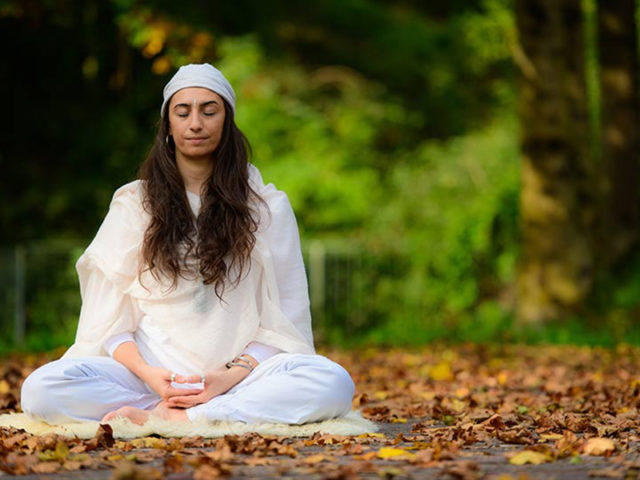Perhaps one of the most powerful forms of meditation out there, Kundalini meditation offers an array of benefits, it can help enhance your sense of awareness and mindfulness, promote inner peace and balance and help you de-stress, among others. Here is how you can practice this wonderful form of meditation for a healthier and happier life.
Meditation is hailed as one of the most effective tools to promote mental and physical health and wellness all around the world. It is considered to be useful in increasing awareness, promoting mindfulness, reducing stress, and enhancing inner peace. But did you know there are several types of meditations and each comes with its own benefits?
If inner peace, mindfulness and improved cognitive functioning are your goals, then kundalini meditation is just what you need.
What is Kundalini Meditation?

Kundalini, which means ‘coiled’ in Sanskrit, refers to a type of meditation that is said to help fully awaken a person’s potential for awareness. As per the theory behind this popular form of meditation, life energy can be found at the base of your spine where it is coiled like a snake. This meditation aims at awakening that energy and achieving enlightenment through several techniques including deep breathing, hand movements (mudras), phrases (mantras) and physical movements.
It is believed that these exercises can potentially rouse dormant energy in the body and move it along a person’s energy centres or chakras until it finally reaches the point of release at the seventh chakra (the head). The release of this energy leads to several benefits including internal balance, enlightenment and awakening.
7 Must Know Benefits Of Kundalini Meditation
Kundalini meditation has a long list of benefits associated with it. A few of these benefits are backed by studies and research conducted on Kundalini yoga, which basically involves kundalini meditation. Let’s take a look at how this meditation can help you bring positive changes in yourself as well as your lifestyle.
1. Enhanced concentration

Kundalini meditation is believed to aid in enhancing concentration and ensuring that you are not thrown ‘off balance’ by random thoughts.
2. State Of Mindfulness

This meditation may lead to more awareness and intention in your daily life. It helps in breaking your automatic daily routine and help you get into a state of mindfulness. It leads to the creation of balance in mind, body and soul.
3. More Creative Energy

Regular practice of Kundalini meditation can also help build up your creative energy.
4. Helps With Anxiety

Another major benefit of practicing this meditation is reduced anxiety levels. According to studies, Kundalini meditation may be effective in reducing symptoms of generalized anxiety disorder.
5. Reduced Stress

According to studies, this type of meditation may also offer immediate relief from stress. It is also suggested that this may, in turn, be helpful for conditions associated with high-stress levels (like insomnia and cardiovascular ailments.
6. Improved Cognitive Functioning

Research has also found this meditation to help improve cognitive functioning like improved memory and executive functioning.
7. Helps Resolve Sleep-Related Issues

Another potential benefit of Kundalini yoga meditation is that it may help improve sleep and resolve sleep-related issues.
While these are the major benefits of Kundalini meditation, the list does not end here. People who practice it on a regular basis have also reported experience benefits like improved communication (with self and others, a clear mind, increased compassion, a more developed sense of self, greater purpose, greater intent in actions and expanded lung capacity (better breathing!).
A 5-Step Process To Practice Kundalini Meditation Correctly

Preparation
Here’s how you can prepare for your Kundalini meditation session.
- Find a comfortable and distraction-free space. You can choose your favourite spot at home or just any place where you are less likely to be bothered.
- Don’t forget to keep a water bottle beside you.
- A lot of practitioners like to wear loose, comfy, cotton clothing for this meditation. Choose clothes that feel right to you. Just make sure your clothes are clean and fresh. You can also opt for light-coloured clothing to enhance the feeling of lightness.
- Choose a suitable time to practice Kundalini meditation. You can do this just after you wake up in the morning or just before you go to bed at night. Any time when you are less likely to be disturbed will do. However, it is recommended to avoid practicing Kundalini meditation right after a big meal when your body is still busy digesting the food.
- Choose a suitable length of practice.
- A mantra can help you focus while you breathe. Choose a mantra that is akin to your beliefs or goals.
Kundalini meditation for beginners

Now that you are finally ready to begin your meditation, here’s what you need to do.
- Step 1: Get into a comfortable position that allows you to sit upright and keep your spine straight. You can sit cross-legged on the floor or in a chair with your body weight resting on your feet. You can even spread a wool or cotton blanket where you sit or put a pillow underneath for comfort. You can position your hands in a prayer pose.
- Step 2: Next, softly close your eyes so that they are around 90 per cent closed. Now start chanting the mantra you chose as you inhale and exhale. You can chant out loud or silently in your head. If you are saying it out loud, actively listen to your own voice. In case you are chanting in your head, try visualizing your mantra being written down. Chanting will help you direct your energy.
- Step 3: Focus on your breathing and slowly begin to slow it down. The goal is to make sure a single round of inhaling and exhaling lasts about 7-8 seconds. Try breaking the inhaling and exhaling into different segments, doing short inhales or exhales broken up by pauses. Aim to ensure that during a complete breath, there are about 4 segments of both inhales and exhales. Make sure you are breathing through your nose the entire time., If you feel lightheaded, stop right away.
- Step 4: As you chant and breathe, concentrate on how the breath is moving through your body and leading to a state of relaxation. If you begin to lose focus, try bringing it back consciously to your breath and mantra. Focus on letting your thoughts come and go. Look for a feeling of energy moving along your spine.
- Step 5: Continue breathing and chanting throughout your predetermined length of the meditation session. You can set a timer or alarm to know when to stop. Once the time is up, finish meditating by inhaling deeply and then raising your arms in the air or pushing your palms together. Then relax and exhale.
Conclusion

Kundalini meditation is usually practiced to experience the release of energy or ‘Kundalini awakening.
Even if Kundalini meditation doesn’t lead to an ‘awakening’, it can still prove to be beneficial for you in many ways. Most of these benefits are achieved only after regular practice so make sure you keep working towards your goals with patience and dedication.
Frequently Asked Questions

Question: How long should I meditate?
Answer: That actually depends on you. Ideally, you should start small and aim to increase your meditation time gradually. You can choose anything between 3 minutes to 21/2 hours. Consider factors like your schedule and your goals before setting a session length. A few common choices are 11 minutes, 22 minutes, 31 minutes etc
Question: Is Kundalini meditation dangerous?
Answer: While this experience can be a spiritual one, it may seem a little overwhelming if you are unsure about what to expect. Before you incorporate Ohso kundalini meditation into your daily schedule, make sure you are ready for the experience.
People practicing this meditation have reported a feeling of warmth, tingling, disorientation, temporary discomfort or other physical sensations during kundalini awakening.
Moreover, since meditating involves deep breathing exercises, and if you are not used to it, you may end up feeling lightheaded or dizzy. Take a break if you feel discomfort. Also, make sure you drink plenty of water before beginning your session and after completing it as well.
Question: Can I practice kundalini meditation while lying down?
Answer: The answer is yes. In fact, some of the most effective Kundalini techniques are performed while lying on the back (for example prana vidya). This pose works quite well for meditation as well as breathing exercises. You can be on the floor or the couch. If you want to practice Osho kundalini meditation out in the open (especially during summer down), lie down in your garden or lawn.


